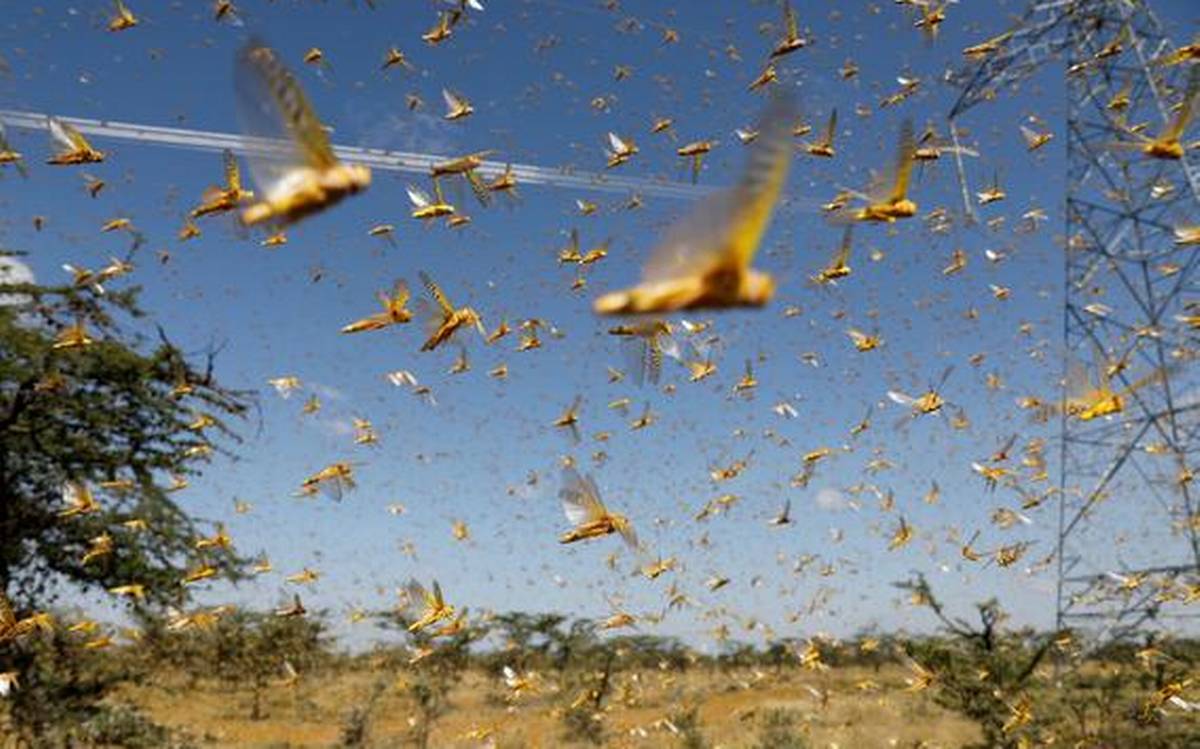Government machinery is ready to spray chemicals, pesticides from choppers and fire tenders.
Hyderabad: Telangana which is in the grip of invisible coronavirus is faced with another menace of millions of locusts currently on Maharashtra borders which pose a bigger threat to crops and cattle feed. The state has readied itself to wage a battle with the locusts by equipping with helicopters, drones and a fleet of fire tenders, besides an army of farm volunteers to take on the tropical grasshoppers.
The government machinery is ready to spray chemicals and pesticides from helicopters and fire tenders on the locusts, besides planning to beat drums and set forests afire to ward off the marauding insects. Hundreds of volunteers from nearby villages have been roped in to kill or repulse the locusts and the borders of Telangana-Maharashtra now present a war-like atmosphere, according to locals.
Though locust attacks are not uncommon once in a few decades, this time, the situation is alarming as rural areas and agricultural fields were abandoned for a few weeks due to the Covid-19 induced lockdown since March last week. This time, the locusts have entered India via Pakistan in the early April and created havoc in Rajasthan, parts of Gujarat and Maharashtra.
As the grasshoppers destroy all vegetation, especially the crops that are in early stages at a raid speed, farmers are the worst sufferers whenever they attack. Lakhs of acres of crops were destroyed by these tiny grasshoppers which breed in no time. The Locust Warning Organization (LWO) located in Jodhpur, a wing of Union Ministry of Agriculture, is working round-the-clock to tackle the locust threat.
Telangana Chief Minister K. Chandrasekhar Rao (KCR) has set up a high level experts’ panel and pressed into service teams of officials and declared a sort of emergency in Adilabad district, on the border of Maharashtra. Plant protection expert Dr Sunitha, principal agriculture scientist S.J. Rahaman, Forest conservator Md. Akbar and Mancherial police commissioner V. Satyanarayana are in the panel.
The panel members along with Mancherial district collector Bharati Holikere are camping in Godavari Khani city and monitoring the situation round-the-clock. A helicopter, some fire tenders and drones are kept at their disposal. On Friday, these officials surveyed by chopper the areas on the borders of Maharashtra and Chhattisgarh and came to the view that the locusts were moving slowly.
As the locust moves with winds which are currently blowing towards Madhya Pradesh and Chhattisgarh, there is no immediate threat to Telangana, but vigil cannot be lowered till at least two to three more weeks, said Telangana agriculture secretary Dr B. Janardhan Reddy. “As of now, we are ready with lotions of monocrotophos and other pesticides,” said Dr Reddy.
Officials of LWO, too, are in touch with the states and guiding them to tackle the menace of locusts, but different states have been following different methods on this. Some agriculture scientists have also suggested spraying mud waters on plants so that the locusts cannot eat them and die over a time. But, Rajasthan and Maharashtra have been using chemical pesticides.
Luckily, this is not a crop season in India so that there is not much damage to agriculture, but the locusts that thrive on other vegetation have destroyed cattle feed, which may turn calamitous to farmers. In Adilabad district, horticulture crops are now on an area of 36,000 acres and officials have taken steps to protect them from locust.
The locusts, which have originated from East African countries attack in swarms spread over 3 to 4 km radius, are difficult to contain. However, now they are in small swarms up to a km, so the threat is less. Currently, a thick cloud of locust is spread over an area of a few km, from Ramtek in Maharashtra to border of Madhya Pradesh and it is moving eastwards.
According to sources from the LWO, as many as 23 swarms of locusts have entered India from Pakistan and their intensity is unlikely to come down before July end. The LWO has deployed 47 ground teams to spray chemicals and take other measures to curb the menace. Efforts are underway to see that the threat is completely eradicated before the onset of the Kharif season that picks up in July last week.

